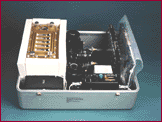





Objectives
The objective of this experiment was to study the growth of binary colloidal alloy crystals and colloid-polymer gels by photography to assist in optimizing sample choice for future experiments, Physics of Colloids in Space, scheduled to fly in the express rack on the ISS. The glovebox experiments help mitigate the risk of the ISS experiment.
Shuttle-Mir Missions Approach Results
Collapse of colloid polymer gels that is observed on the ground was confirmed to be due to gravity. In microgravity, no collapse was observed. Binary colloidal alloys were observed to grow more rapidly in microgravity than on Earth, and the concentration that yielded the best results was observed to be different than on the ground. This is essential information for judicious choice of samples for PCS. It also indicates that gravity plays a subtle role in the crystallization which is, as yet, not understood.
Earth Benefits Publications Principal Investigators Co-Investigators![]()
NASA-3, NASA-6
BCAT 1 consisted of two different types of studies which included (1) fast growth and (2) slow growth. Fast growth samples were photographed over the course of several days at the beginning of the mission. The purpose of studying fast growth was to determine if collodial collapse, observed on the ground, was caused by gravity. Slow growth samples were used to study the formation of different types of collodial mixtures at different concentrations over a long period of time. In general, photographs were taken of samples about twice a day; video colloid-polymer gels with low magnification microscope for several hours. BCAT 2 was designed to add to existing information base from the BCAT 1 by studying collodial structures over an extended period of time.
Pictures of binary colloid alloys were obtained; video of colloid-polymer gels were obtained.
The advantages of studying colloids in microgravity is the improvement of next generation development of light switches, displays, and optical devices to be used in computers and communications.
None available at this time.
Dave A. Weitz, Ph.D.
University of Pennsylvania
Prof. P.N. Pusey
Dr. P.N. Segre
![]()
|
|
Curator:
Julie Oliveaux
Responsible NASA Official: John Uri |
Page last updated: 07/16/1999
.gif)